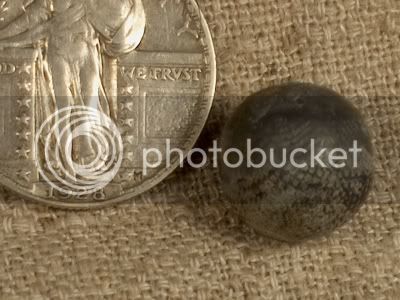The only deformity was to the base of the bullet where it was up against the bone.
What would perform better in terms of creating a blood trail and bullet expansion?
The problem we have with our ml projectiles is that even pure lead is not going to expand much at impact velocities below around 1100 to 1200 fps. Balls expand because most of them are impacting above that velocity but conicals usually are not, depending on the distance to the shot.
My own chronographing of .50 maxi balls showed 80 grains of ff getting it to about 1312 fps. Upping it to 100 grains did not increase velocity enough to make a difference, but it sure did make a difference in recoil! :shocked2: :haha:
The configuration of the tip of the conical will have some bearing as well. The pointy tip of the maxi is less prone to expansion than a broader flat point. The other problem with the maxi is also related to that pointy tip in that it will tend to change direction during impact. This effect is notabley observed in modern guns shooting "solids" for penetration on large tough animals such as buffalo and elephant. The true straight penetrators are the ones with an abrupt round nose or a round nose flatpoint. The pointy solids don't maintain their direction of travel. I'm not saying they aren't deadly, just that they are not as instantaneous as one would like!
Note what round ball says about the Maxi Hunter. It has a more flat point and will be a straighter penetrator and the flat nose will do more damge
even if it is not moving fast enough to expand much. This points up (no pun intended

) the advantage of the flat nose ml bullet.
If you consider my own maxi ball exp at 1300 fps, you can see that by the time it reaches 50 yards it is under 1200 fps and at 100 yards it is under 1100 fps. I killed an elk with that same set up but with 70 grains of ff. 130 yard shot, double lung, stopped under the skin on the far side. That bullet started out at about 1200 fps and was going under 1000 at impact. It centered a rib going in and that barely smeared the lead on the point of it (cast from pure lead).
You might say that it worked just fine, but the fact is, the elk stayed alert and on it's feet for better than 30 seconds. Elk are funny in that they are often reluctant to flee wothout knowing what the danger is. This elk was alone and had no idea what had happened. If he had made an all out run it would have been tough finding him in the thick black timber that surrounded the small meadow he stood in. That elk did not bleed externally at all!
My suggestion is that if you are going to use conicals that you select one like the Lyman Great Plains mold with its broad flat nose.
Personally, I have found that blood trails are not present often enough to make them a reliable tracking method. I have hit deer and elk with pass through shots with round balls, conicals. modern bullets, and very sharp broadheads. The ones that did not go down on the spot rarely left a blood trail. I had one elk hit double lung across the top of the heart that ran for 100 yards and did not spill a single drop of blood in that entire distance :shocked2: Another, a large mule deer doe was hit double lung with a very sharp broadhead pass through (the arrow continued out of sight and was never recoverd). That doe went about 75 yards without spilling a single drop either and in fact there was very little blood on the ground where she piled up!











